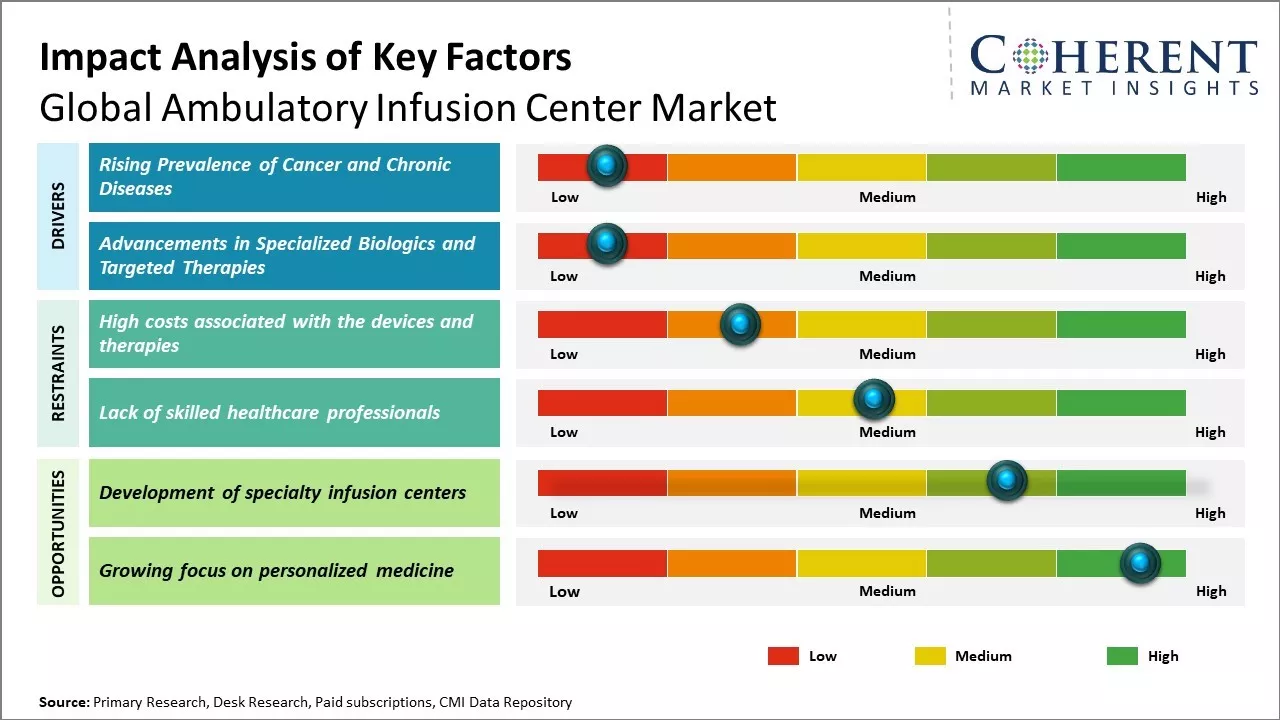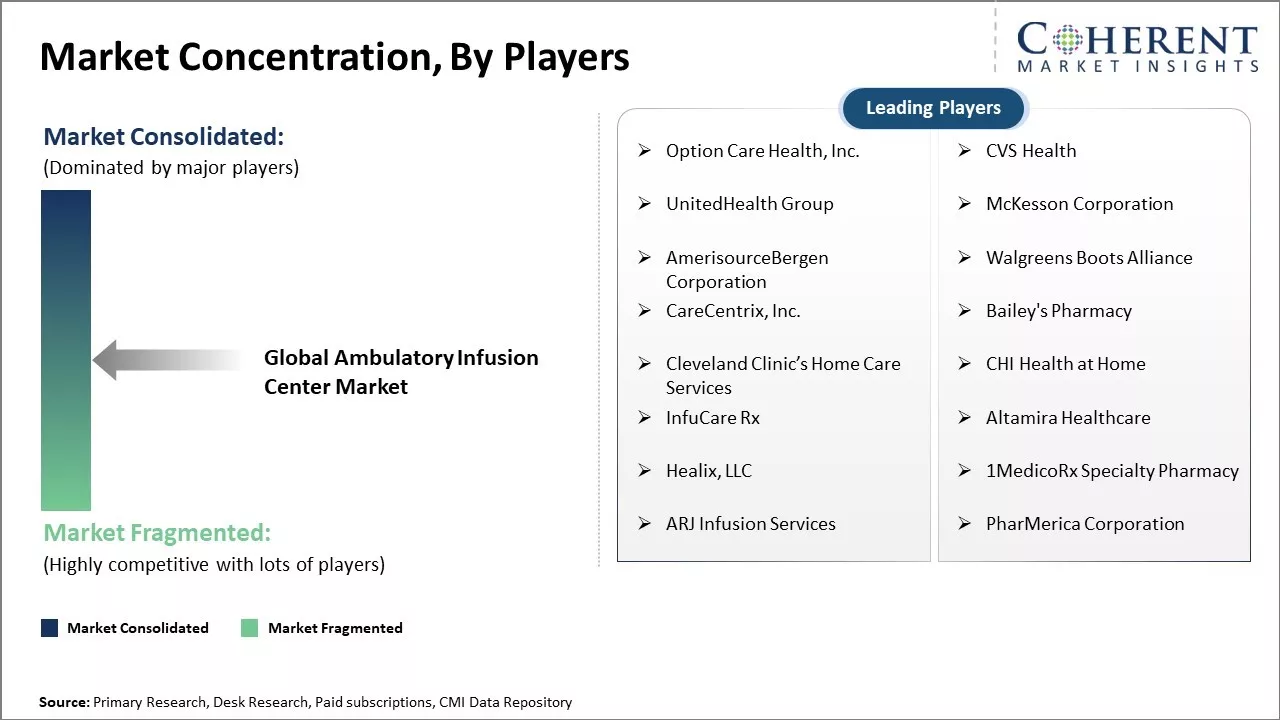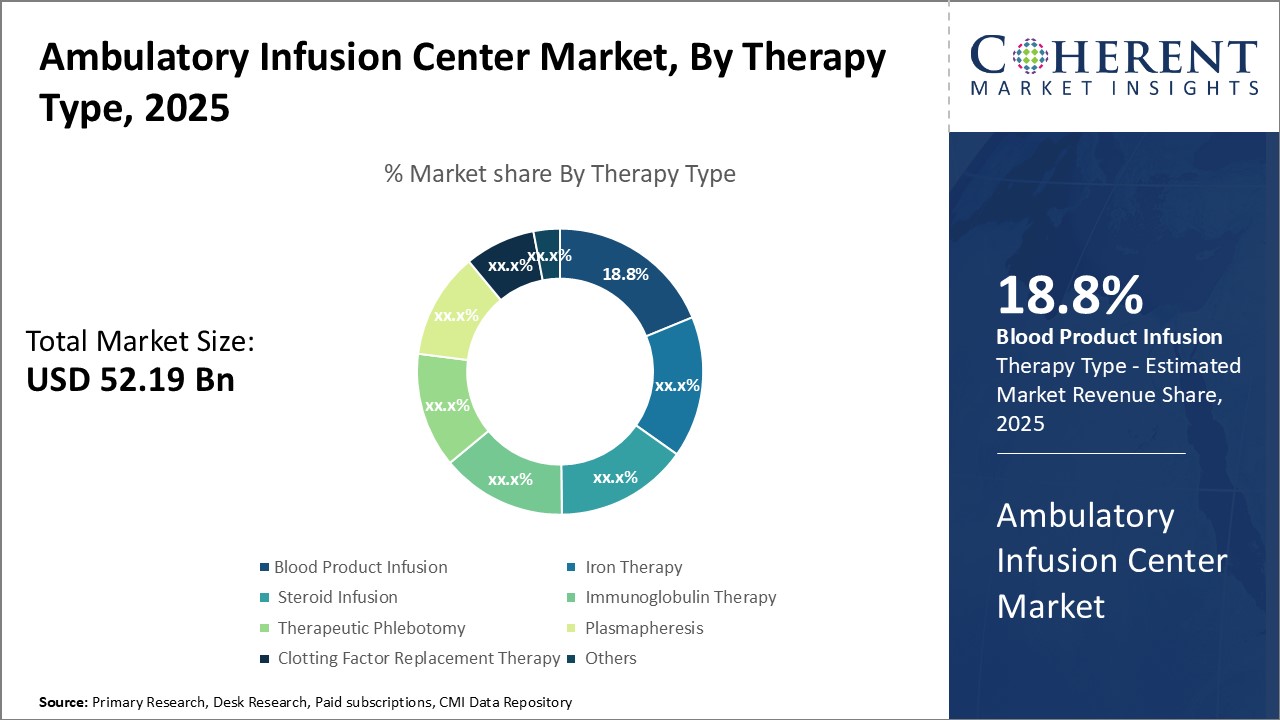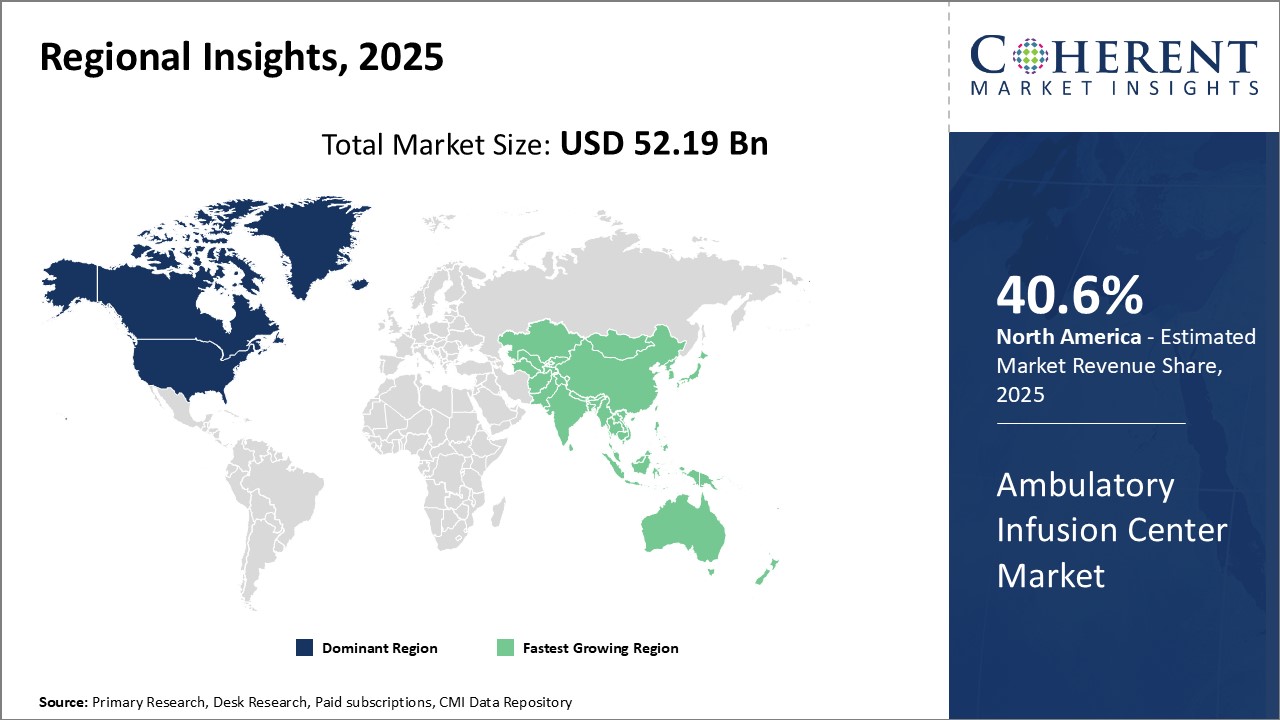The global ambulatory infusion center market is estimated to be valued USD 52.19 Bn in 2025 and is expected to reach USD 107.07 Bn by 2032, exhibiting a compound annual growth rate (CAGR) of 10.8% from 2025 to 2032.

Discover market dynamics shaping the industry: Download Free Sample
The ambulatory infusion center market is expected to witness significant growth during the forecast period. The development of technologically advanced infusion pumps, rising prevalence of chronic diseases such as cancer and Crohn's disease requiring long-term treatment therapies, and growing preference for outpatient care are major trends contributing to the market growth. Ambulatory infusion centers offer convenience and lower care costs by transitioning routine care traditionally provided in the inpatient setting to outpatient facilities. This trend is expected to continue as infusion therapies advance and healthcare costs remain high, boosting the demand for efficient ambulatory infusion services.
Rising Prevalence of Cancer and Chronic Diseases
With the changing lifestyle patterns across the globe, the prevalence of various chronic and life-threatening diseases has increased manifolds in the past few decades. Two of the major disease categories pushing the need for ambulatory infusion services are cancer and other chronic diseases. As per various research studies and reports by healthcare organizations, cancer has now emerged as one of the leading causes of mortality worldwide. Just in the U.S., an estimated 1.8 million new cancer cases are diagnosed and over 606,000 cancer deaths occur annually. While some cancer types can be treated with oral medication, many advanced cases require photopheresis, chemotherapy, hydration, or pain management which can only be provided through IV infusions administered on an outpatient basis. Additionally, the rise in risk factors like smoking, obesity, and physical inactivity has also led to a surge in chronic health conditions like diabetes, cardiovascular diseases, autoimmune disorders, and others. All these chronic diseases may also need long term infusion therapy to stabilize the condition or to improve the quality of life. The growing prevalence of cancer and chronic diseases is thus driving more patients towards outpatient ambulatory infusion centers where they can receive specialized treatments in a relaxed setting while continuing with their daily routines. For instance, in February 2024, updated worldwide cancer burden estimates for 2022 were released by the WHO's International Agency for Research on Cancer (IARC) in February 2024, ahead of World Cancer Day. These figures included 20 million new cases and 9.7 million deaths. According to a WHO survey, there is inadequate coverage of cancer care and palliative services under universal health care in many countries. These findings highlight significant inequities and emphasize the need for prompt action to advance these services.

Get actionable strategies to beat competition: Download Free Sample
Advancements in Specialized Biologics and Targeted Therapies
Over the last decade, there have been unprecedented advancements in drug development, resulting in a variety of new biologics, immunotherapies, and targeted treatment options. Unlike conventional chemotherapy which aims to destroy fast-dividing cells, these new generation therapies are highly specialized and focus on specific molecular targets associated with certain types of cancers and chronic diseases. While effective, many such biologics including monoclonal antibodies, stem cell therapies, and gene therapies can only be administered intravenously. Therefore, to benefit from these complex and cutting-edge IV-based therapies, patients routinely require long-term or lifetime infusion access in an ambulatory setting. This allows for the convenient administration of treatments at flexible timings over extended periods without disrupting daily activities or work schedule. The approvals of a growing number of targeted biologics coupled with oncology research exploring new infusion-based combinations is fueling the need for expanded outpatient infusion facilities across the globe. This has become a major driver responsible for the significant rise in demand for ambulatory infusion services worldwide.
Key Takeaways from Analyst:
The global ambulatory infusion center market is expected to experience steady growth over the forecast period driven by the increasing prevalence of chronic diseases and rising popularity of ambulatory care services among patients. Ambulatory infusion centers offer convenient and cost-effective alternatives to hospital-based outpatient and inpatient care for infusion therapies. North America currently dominates the market owing to the higher acceptance of advanced healthcare facilities compared to other regions. Asia Pacific is projected to be the fastest growing regional market due to the rapidly improving healthcare infrastructure and rising medical tourism across countries like India and China.
While ambulatory infusion centers provide valuable services to patients, their growth may be hindered by lack of awareness regarding these facilities as well as availability of substitutes like home infusion services. Staffing and retaining qualified nurses trained in infusion therapies poses a challenge and increases operational costs for market players. However, growing preference for minimally invasive procedures and convenience offered by ambulatory centers is expected to boost their demand over hospitals. Further, the ongoing healthcare reforms pushing for affordable care with improved outcomes will drive more payers and providers to utilize these centers. Innovation in infusion therapies, expansion of insurance coverage, and favorable reimbursement scenarios also present significant opportunities for ambulatory infusion center providers.
Market Challenges: High costs associated with the devices and therapies
High costs associated with devices and therapies have been a major obstacle in the widespread adoption of ambulatory infusion centers globally. The expenses incurred on advanced medical equipment, professional healthcare services, and pharmaceutical drugs administered through these centers are significantly high. This makes treatment through ambulatory infusion centers unaffordable for a large section of population worldwide especially in underdeveloped and developing nations. The equipment required for safe and effective infusion of drugs outside hospital setup is expensive. Devices like large volume infusion pumps, vital sign monitors and consumables like sterile collection bags, medication bags, tubing sets, etc. attract high prices. Similarly, costs of biologics, antibodies, and specialty pharmaceuticals used through ambulatory infusion are also on the rise.
Market Opportunities: Development of specialty infusion centers
The development of specialty infusion centers could usher in a tremendous opportunity for the global ambulatory infusion center market. Specialty infusion centers are standalone, free-standing facilities dedicated to providing infusion therapies for specific conditions or patient populations. As the demand for non-emergency outpatient infusion therapies rises, specialty centers will become increasingly crucial for efficient and effective service delivery. Various trends underscore the promising future of specialty infusion centers. Chronic diseases requiring long-term IV drug therapy are on the uptick globally. For example, the number of people diagnosed with diseases like cancer, multiple sclerosis, and rheumatoid arthritis is projected to increase over the next few years according to the World Health Organization. Moreover, biologics and specialty pharmaceuticals administered through intravenous methods are at the forefront of innovation in medicine. As novel and high-cost infusion drugs enter the market at an exponential rate, specialty centers can ensure optimum clinical management and monitoring for patients on these therapies.

Discover high revenue pocket segments and roadmap to it: Download Free Sample
By Therapy Type- Growing Prevalence of Chronic Diseases Fuels the Demand for Blood Product Infusion
In terms of therapy type, blood product infusion is expected to contribute the highest share of the market, accounting for 18.8% in 2025 owing to the growing prevalence of chronic diseases and conditions that require blood transfusion therapy. Blood product infusion is commonly used for blood replacement in patients suffering from severe blood loss during surgeries, childbirth, or accidents. It is also useful in treating diseases associated with low hemoglobin levels such as iron deficiency anemia. The rising geriatric population worldwide is another key driver as older adults are more prone to chronic illnesses and injuries that may necessitate blood replacement. Moreover, the adoption of unhealthy lifestyles and increasing environmental pollution has led to a surge in lifestyle-related chronic disorders over the past few decades. With limited treatment options available for certain life-threatening conditions, blood infusion therapy continues to be irreplaceable.
By Application - Growing Prevalence of Autoimmune Disorders Boosts the Demand for Chronic Inflammatory Disorders Treatment
In terms of application, chronic inflammatory disorders is expected to contribute the highest share of the market, accounting for 30.62% in 2025 due to the growing prevalence of various autoimmune conditions globally. Chronic inflammatory disorders refer to diseases characterized by prolonged inflammation that can damage tissues over a long period of time. Some of the most common autoimmune disorders driving the growth of this segment include rheumatoid arthritis, inflammatory bowel disease, multiple sclerosis, and lupus. The rising environmental and genetic factors that are known to increase the risk of developing autoimmune conditions have catalyzed the incidence rates. In addition, aging populations across countries are susceptible to chronic inflammatory disorders. Autoimmune diseases require long-term therapy approaches including targeted drug infusion to control flare-ups and slow disease progression. This continuous requirement of infusion therapies will continue supporting the growth of this segment.
By Site of Care- Preference for Hospital-affiliated Centers Augments their Dominance
In terms of site of care, hospital-affiliated centers is expected to contribute the highest share of the market, accounting for 40.71% in 2025. These centers are preferred primarily due to the convenience of one-stop care and the availability of better infrastructure and facilities under one roof. Hospital-affiliated ambulatory infusion centers provide dedicated outpatient services and are mostly located within the hospital premises. This eases accessibility and ensures seamless transitions between emergency hospitalization (if required) and continued outpatient care. The presence of qualified healthcare professionals, modern medical equipment, and in-house diagnostic services further add to their popularity over other alternatives. Additionally, most major insurance providers have preferred provider contracts with hospitals offering coverage for services provided at affiliated ambulatory centers. This insurance network and coverage factor aids the leading position of hospital-affiliated centers in this segment.

Need a Different Region or Segment? Download Free Sample
North America has dominated the global ambulatory infusion center market, and it is expected to account for 40.6% of the market share in 2025. The large size of the healthcare industry in the U.S. contributes significantly to the region's market share. Several leading pharmaceutical and medical device companies that offer infusion therapies have their headquarters in the U.S., driving easy accessibility and high adoption of these services. In addition, favorable reimbursement policies for outpatient infusion therapies encourage more patients to opt for ambulatory infusion centers rather than hospital-based treatment. This has further boosted the number of such centers across the region over time.
Asia Pacific is poised to be the fastest growing regional market during the forecast period. Rapid economic development and rising healthcare expenditures have improved access to sophisticated medical treatments in several Asia Pacific countries. China and India, in particular, represent major opportunities for players in this market. While in-hospital infusion services still account for the majority of the market in Asia Pacific, growing preference for convenience and cost-effectiveness is propelling the ambulatory infusion center segment. Established players from North America are also entering new markets in Asia Pacific through collaborations with local providers, supporting the regional market growth.
Ambulatory Infusion Center Market Report Coverage
| Report Coverage | Details | ||
|---|---|---|---|
| Base Year: | 2024 | Market Size in 2025: | USD 52.19 Bn |
| Historical Data for: | 2020 To 2024 | Forecast Period: | 2025 To 2032 |
| Forecast Period 2025 to 2032 CAGR: | 10.8% | 2032 Value Projection: | USD 107.07 Bn |
| Geographies covered: |
|
||
| Segments covered: |
|
||
| Companies covered: |
Option Care Health, Inc., CVS Health, UnitedHealth Group, McKesson Corporation, AmerisourceBergen Corporation, Walgreens Boots Alliance, CareCentrix, Inc., Bailey's Pharmacy, Cleveland Clinic’s Home Care Services, CHI Health at Home, InfuCare Rx, Altamira Healthcare, Healix, LLC, 1MedicoRx Specialty Pharmacy, ARJ Infusion Services, and PharMerica Corporation |
||
| Growth Drivers: |
|
||
| Restraints & Challenges: |
|
||
Uncover macros and micros vetted on 75+ parameters: Get instant access to report
Share
Share
About Author
Komal Dighe is a Management Consultant with over 8 years of experience in market research and consulting. She excels in managing and delivering high-quality insights and solutions in Health-tech Consulting reports. Her expertise encompasses conducting both primary and secondary research, effectively addressing client requirements, and excelling in market estimation and forecast. Her comprehensive approach ensures that clients receive thorough and accurate analyses, enabling them to make informed decisions and capitalize on market opportunities.
Missing comfort of reading report in your local language? Find your preferred language :
Transform your Strategy with Exclusive Trending Reports :
Frequently Asked Questions
Joining thousands of companies around the world committed to making the Excellent Business Solutions.
View All Our Clients